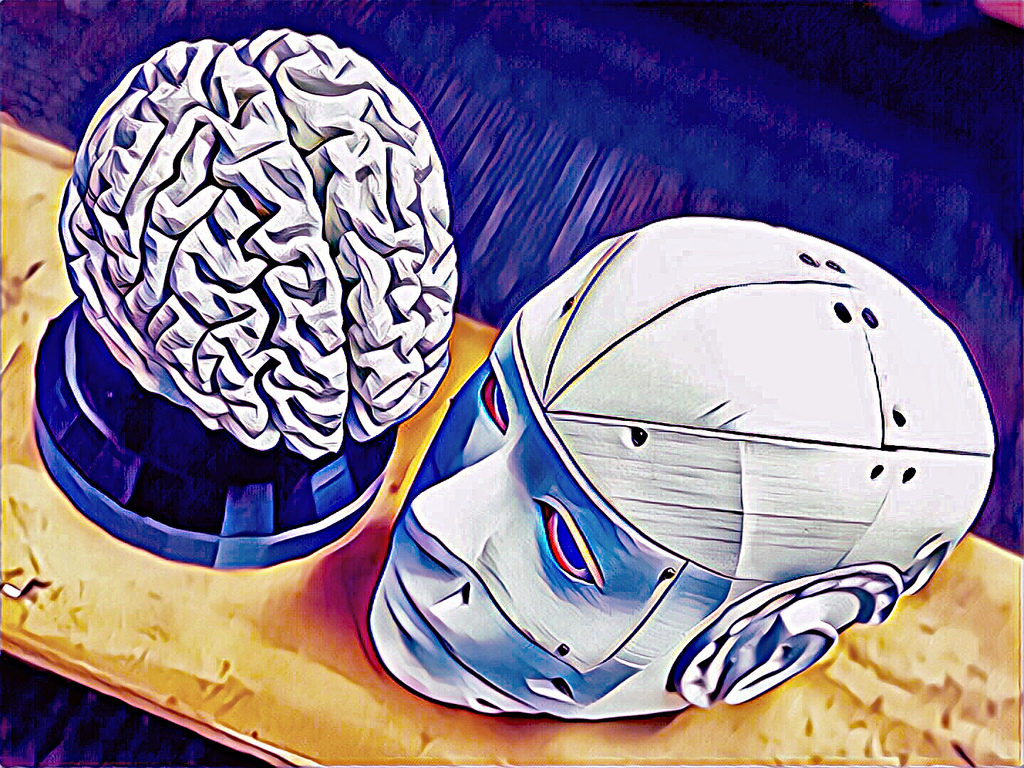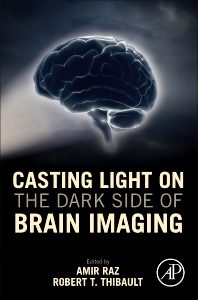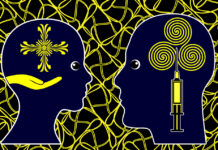A chapter in the recently published book, Casting Light on the Dark Side of Brain Imaging, provides a fresh perspective on neuroimaging and the mindful brain. The authors of the chapter, philosophers Michael Lifshitz and Evan Thompson, challenge the current neurocentric view of the mindfulness phenomenon in the west and invite readers to expand their understanding of the Buddhist concept.
“Contrary to the neurocentic view, we see meditation as a deeply social, and fundamentally embodied collection of practices,” Lifshitz and Thompson write. “If we reduce meditative practices to a set of brain patterns, we miss the richness of how these practices work and ignore much of what they have to teach us about human experience.”

Research on mindfulness in the west has exploded over the last 40 years. The concept has been invoked for everything from helping one become a better leader, to reducing workplace burnout, to treating psychiatric disorders. With a plethora of mindfulness apps, the buzz in the tech world, and a growing body of research, the practice rooted in Buddhist philosophy has become a widespread western phenomenon.
It comes as no surprise that scientists have begun exploring the effects mindfulness has on the brain. Brain scans of Buddhists monks (“the “Olympic athletes” of meditation,” as Lifshitz and Thompson write) demonstrate stronger and more robust brains. One study suggests that even after only eight weeks of formal meditation practice by a novice noticeable changes to the brain can be detected.
 Although research of this kind remains in its infancy, it’s understandable why the west, known for high productivity and a “doing” mode of thinking, would be excited about such results. “If there’s one thing our contemporary culture values more than individual self- determination, it’s tangible results. We put our faith in what we can measure,” write Lifshitz and Thompson.
Although research of this kind remains in its infancy, it’s understandable why the west, known for high productivity and a “doing” mode of thinking, would be excited about such results. “If there’s one thing our contemporary culture values more than individual self- determination, it’s tangible results. We put our faith in what we can measure,” write Lifshitz and Thompson.
While the prospect of “proving” that mindfulness works by demonstrating changes detected on brain scans is attractive, reducing the practice to a “specific brain signature” may be a misguided view of mindfulness entirely.
“Any repetitive activity you do is likely to leave lasting traces on your brain. Learning to play an instrument, acquiring a second language, playing video games, or even staring at lines on a screen—all of these activities have been shown to mold the brain.”
In their chapter, Lifshitz and Thompson employ the example of parenting to illuminate how a reductionistic view of mindfulness misses the concept entirely. Practicing parenting skills indeed change the brain; however, “Good parenting isn’t inside the brain; it’s a way in which the whole person (including the brain) is engaged in the world. Moreover, what counts as good parenting differs depending on the culture. So, appealing to the brain simply won’t tell us what it means to be a good parent.”
“Even if we assume that the brain changes reported in neuroimaging studies of meditation are robust, there remains a deeper conceptual problem with the idea that we can map (let alone reduce) complex behaviors or mental processes to changes in particular regions or networks of the brain.”
Instead, Lifshitz and Thompson argue that mindfulness concepts are a “complex orchestration of cognitive skills embodied in a particular social context.” And that more is involved in the practice than brain changes. While brain scans certainly add to a global understanding of mindfulness, the practice itself cannot be captured by these scans.
“The body also plays a crucial role in mindfulness meditation. Many traditions of meditative practice consider the posture of the body to act as a mirror of the mind. When attention dulls, the posture slackens. When thinking becomes agitated or aggressive, the muscles become stiff and taut. Mind and body are bound together.”
The authors conclude:
“Moving past a neurocentric view of mindfulness promises not only to improve the science of meditation but also to counteract the pernicious idea that taking care of our mind is just a matter of regulating our own internal states. Part of what meditative practice reveals is that our minds are intrinsically tied up with our bodies and with the larger social and ecological contexts in which we are embedded. We hope for a science that would make us more, not less, mindful of how our brains fit into this bigger picture.”
****
Lifshitz, M., & Thompson, E. (2019). What’s wrong with “the mindful brain”? Moving past a neurocentric view of meditation. In Casting Light on the Dark Side of Brain Imaging (pp. 123-128). Academic Press. (Link)















“We hope for a science that would make us more, not less, mindful of how our brains fit into this bigger picture.”
Sounds a little, tiny bit like a confession, that you “mental health” workers don’t have a scientific clue about how our brains actually function. Which all of us here know is the reality. Oh, but it’s all wrapped up in your newest fad. So as to cover up your enormous crimes against humanity, including your ongoing modern day, psychiatric holocaust of Western civilization.
https://www.naturalnews.com/049860_psych_drugs_medical_holocaust_Big_Pharma.html
But primarily its just a modern day psychiatric holocaust of child abuse survivors, children, women, blacks, and the elderly.
https://www.indybay.org/newsitems/2019/01/23/18820633.php?fbclid=IwAR2-cgZPcEvbz7yFqMuUwneIuaqGleGiOzackY4N2sPeVXolwmEga5iKxdo
https://www.madinamerica.com/2016/04/heal-for-life/
https://www.alternet.org/2010/04/are_prozac_and_other_psychiatric_drugs_causing_the_astonishing_rise_of_mental_illness_in_america/
http://myeclinik.com/psychiatric-drugs-kill-500k-western-adults-annually/
Good God, if you’re killing 500,000 65+ and older adults a year, plus you’ve created a completely iatrogenic “childhood bipolar epidemic,” which no doubt also applies to all the “bipolar” misdiagnosed adults. How many people are you “mental health” workers actually killing a year with your psychiatric drugs?
Was it in the ballpark of 783,936 per year, as of the turn of the century?
http://www.webdc.com/pdfs/deathbymedicine.pdf
Plus we know the mass psychiatric drugging, including the opioid drugging, and resulting medical murders have increased staggering since the turn of the century. So how many are you murdering now a year, “mental health” workers, and all doctors?
Our society is dealing with a modern day, ongoing, iatrogenic illness creating, psychiatric holocaust that the “mental health” workers have yet to confess to, make proper amends for, nor have you even changed your evil ways. Despite your BS DSM “bible” being declared “invalid” in 2013 by many, including the head of the National Institute of Mental Health, and more than one prior DSM chairperson.
https://www.nimh.nih.gov/about/directors/thomas-insel/blog/2013/transforming-diagnosis.shtml
https://www.psychiatrictimes.com/addiction/psychiatric-diagnosis-gone-wild-epidemic-childhood-bipolar-disorder
The “mental health” workers must get rid of their BS Diabolical Stigmatization Manuel (DSM). And since you’ve all been raping the entire US economy for your malpractice insurance, you likely need to also repent, and properly compensate all those you’ve harmed, if you want the judge of your soul to ever believe any of you actually wants forgiveness.
Our society had (has) rules, and you “mental health” workers didn’t abide by them, and instead chose to betray all of Western civilization. Wake up, you “delusions of grandeur” filled “mental health professionals” are NOT actually God.
Report comment
We live in a culture in which normal is considered healthy, but in general, normal is too disconnected to meet our needs. The treatments and drugs mostly serve the purpose of distracting and inhibiting our minds from the pain of disconnection. People use the rules of culture to compete for something that should not require competition. Why?
Report comment
With mechanization, birth control, and resources the world has never been richer – but it’s being hoarded by the few.
Report comment
Well said.
Report comment
If mindfulness was an adage and so therefore in a way it is to leave the pointless heretics.
Heroin is not needed to sail into the mountain side waterfall you wash thyself from pain and misery of the world. Whether be:
dorks at school,
abuse at home,
the living of solitude
needs and scariness of loneliness.
Report comment
If practised mindfulness allows a person to detach and move into their own head where everything is (actually) safe.
I found mindfulness very useful (but I wouldn’t medicalise it).
Report comment
Mindfulness is, in the end, a SPIRITUAL practice, which is grounded in Buddhism. Efforts to make it into a utilitarian tool for surviving the rigors of a heartless and isolating modern society I think disrespectful to the true purpose of meditation, which is to free the mind/spirit from its bindings to the cycle of life and death. There is a lot more than “brain activity” going on here!
—– Steve
Report comment
That’s for sure. And the modern society is getting worse and worse.
Report comment
Thanks, Steve.
Most of what western culture thinks of the benefits of meditation are side effects as compared to the original purpose:
Its purpose was to experience the emptiness of the Infinite — the ground of being.
I wrote about this here:
https://www.lifehack.org/349756/the-purpose-meditation-its-not-what-you-think
Report comment
Indeed!
Report comment
Steve, it seems like we just had this conversation about meditation and spirituality on another blog recently. 🙂
Report comment
Seems not unlikely. It’s a point I try to hammer home wherever I can. Few things irk me quite as much as the commodification of spiritually meaningful activities. Corporate capitalism can turn almost anything into crap.
Report comment
The same way they pared down yoga to a useless, commercial proposition.
Report comment
Exactly. Yoga is not just a stretching exercise!
Report comment
Naming the brain as the center of mental (and spiritual?) activity is the result of an Industrial Age love of materialism. This approach to life plays well with most people and has become popular across this planet. While a few of us know this approach to be misguided and really profoundly unworkable, our message falls on mostly-deaf ears. And when the inevitable consequences of our rape of this planet finally catch up with us, it will be too late for most of us to learn the lessons we should have learned last century.
Even if we were to turn this planet around and somehow win the struggle for Sustainable Earth, the planet could still be taken from us by forces currently beyond our control. What we need for the long run is an “exit strategy.” Buddhism has an exit strategy (release from the cycle of rebirth). But that is not what is being talked about in the West regarding the benefits of meditation. And so the West misses the real point of the whole thing.
I very much value the work being done by so many people to dislodge psychiatry from its stranglehold on the field of Mental Health and to find better alternatives. This work buys us time to handle other important aspects of the situation. Bringing more ancient wisdom from the East to the West might help. But Buddhism hasn’t saved the East yet, has it? So, there is much more to learn along this line, far beyond what Buddhism and related Eastern practices have to offer.
Report comment
“Brain scans of Buddhists monks (“the “Olympic athletes” of meditation,” as Lifshitz and Thompson write) demonstrate stronger and more robust brains.”
Stands to reason, given that surrendering effort and control relaxes the mind, body, and spirit, conserves energy and redirects it to where it is most natural and useful, and brings relief from stress. This allows healing to occur naturally via detoxification (letting go of the old) and cellular regeneration (allowing the new). The ego is what gets in the way of good healing.
Report comment
Thanks Alex.
Report comment
Alex,
https://youtu.be/IhUGLDYV9qc
Indirectly from Thich Nhat Hanh.
Report comment
Thanks for this link, Fiachra. She’s excellent! Says it all, letter perfect.
It’s a lifestyle based on exactly what she says–setting an intention and paying attention as the process unfolds, remembering our self-kindness and non-judgment, feeling appreciation and gratitude along the way, and allowing joy in the moment by paying attention and recognizing joyous moments. For me, this work is a panacea, no exaggeration.
I call it the healing & manifesting path, and in the process, it cured me from ALL that ailed me and keeps me in a state of well-being. Same with my partner, we both practice this. That is truth. It is the jewel of my journey, gives meaning and purpose to all of it, even those years of suffering and deep despair. This has been the payoff for us. Learning this turned it all around for us both and we’ve never been healthier and happier.
She’s right, this work does reverse the aging process. And exactly why I say above–it allows cellular regeneration, because when we meditate, we get out of our own way. When we are truly and fully in present time, we are in our power.
I love this path, totally works for me. I teach along these lines, as well.
Report comment
Scientists’ preoccupation with the brain comes from their obsessive need to have everything fit into the ‘theory of evolution.’ What they need to know is that there are different ‘epistemologies’ – i.e., different ways of understanding human experience.
Report comment
I think it goes even beyond that. There is an underlying need to believe in materialism, the idea that nothing can exist that goes beyond the physically observable and measurable universe. Any suggestion that there may be such a thing as a spiritual existence beyond the body, or even the idea that there are extra-physiological phenomena (like the mind) that might arise from the body but transcend it, seem anathema to such people. They seem to believe that materialism is the only way to be “scientific.” Ironic, as they are operating on a non-scientific assumption but are unable to recognize it because they’re so committed to making others whose beliefs are based on non-scientific assumptions wrong.
Report comment
Very true.
Report comment